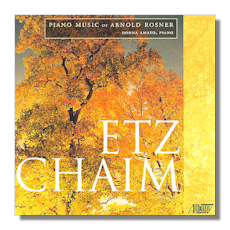
The Internet's Premier Classical Music Source
Related Links
- Rosner Reviews
- Latest Reviews
- More Reviews
-
By Composer
-
Collections
DVD & Blu-ray
Books
Concert Reviews
Articles/Interviews
Software
Audio
Search Amazon
Recommended Links
Site News
 CD Review
CD Review
Arnold Rosner

Etz Chaim
Piano Music
- Adam and Eve, Op. 4 (1961)
- Piano Sonata #1 in F Major, Op. 25 (1963)
- Piano Sonata #2 in A Major, Op. 48 (1970)
- And He Sent Forth a Dove, Op. 49 (1971)
- Wedding March, Op. 53 (1971)
- Piano Sonata #3 "Sonata Eteria" in A minor, Op. 69 (1978)
- Etz Chaim, Op. 99 (1993)
Donna Amato, piano
Albany TROY1119 59:31
Summary for the Busy Executive: Music behind bars.
Hard to believe, but most composers play the piano just well enough to get their business done and use it mainly as a scratch pad to try out ideas and harmonies. Ravel, for example, was an indifferent pianist, who nevertheless understood how to write for the piano. However, with the advent of computer sequencing, this minimal bit of skill among composers may shrink further.
I consider Rosner one of the best composers now writing. He had lessons as a child but, for at least a time, no piano to call his own. On the evidence of this disc, his solo piano writing isn't especially graceful. He writes of himself as fundamentally unsympathetic to the piano and calls it "Mr. Mechanical Man." His best works for the instrument are his accompaniments and the spectacular two-piano Of Numbers and Bells on Albany TROY163. Further, composing attracted him far more, and he began working hard at it during his middle teens. Nevertheless, much of what he wrote early on was piano music, and this disc documents his dual effort with writing for the instrument and with composition in general.
Adam and Eve, written at around 16, nevertheless reveals some Rosner fingerprints: an attraction to modality and "magic modulations," and striving for an epic tone. Hovhaness, Vaughan Williams, and Bloch seem major influences, at this point not completely digested. Rosner attempts an unusual form: A B A+B. A modal chorale contrasts with a faster passage in the octatonic scale (a scale created by alternating whole- and half-steps, or vice versa). At the end, the two ideas combine. The young Rosner pushes himself to create longer forms in the Sonata #1. Despite some interesting passages, neither of these pieces really succeed. They are too much the prisoners of Rosner's limited piano-playing ability, for one thing. For another, in the sonata, the themes are too four-square, passages go on longer than the young composer can sustain, and the textures have little variety. He seems to force things. There's no sense of ease or inevitability. Rosner has since learned these lessons. In his mature work, you get the feeing that he can do anything, that he has options.
And He Sent Forth and the Wedding March are two attractive morceaux. The first has a tinge of Israeli folksong, although the music originates with Rosner. The Wedding March, as Rosner himself points out in the liner notes, will probably never replace Wagner, Mendelssohn, or Pachelbel, but those who want something different might listen to this.
The rest of the program – the two sonatas and Etz Chaim ("tree of life," a Jewish prayer) all contain some marvelous music, but all suffer from Rosner's unidiomatic piano writing. By this time, Rosner has moved beyond the gaucheries of his youth. He does vary texture. He doesn't go on for too long. On the other hand, the right-hand music overpowers the left-hand music, which mostly confines itself to octaves and to bass-note reinforcement. Listening to the Third Sonata and Etz Chaim, I can't shake the feeling that both would blossom in orchestral dress. The Third Sonata contains moments of breathtaking beauty, from its opening measures. The rhapsodic Etz Chaim I think the most complex work on the program, harmonically and rhetorically, but again hampered by the piano. For me, the most pianistic score is the Second Sonata. At least, I'm not thinking of what Bartók or Ravel or Gershwin would have made of it. It allows me to take the piano for granted. It diverges a bit from Rosner's usual musical path, one that seems to accept the piano as a mechanism with more percussive ideas. Rosner cites the inspiration of Bartók and Prokofieff. I like it without reservation.
Donna Amato gives professional, although not especially insightful readings, as if the music at some level foxes her. I don't think this entirely her fault.
Copyright © 2012, Steve Schwartz.




















